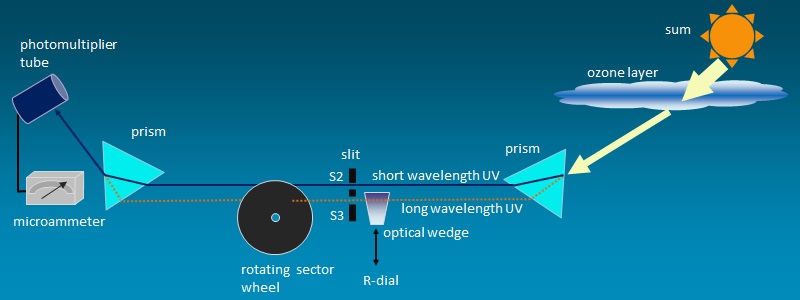Dobson Spectrophotometer Measurement Principle and Automation System
Dobson Spectrophotometer measurement principle
Total ozone observation is conducted using a Dobson spectrophotometer by determining the intensity ratio of a selected pair of UV wavelengths, one of which is strongly absorbed by ozone (shorter wavelength UV1) relative to the other (longer wavelength UV2). The larger [smaller] intensity ratio corresponds to the larger [smaller] amount of ozone in the atmosphere.
The intensity ratio is determined by reducing UV2 intensity to the level of UV1 intensity with an optical wedge. The value is based on the extent to which UV2 is reduced.
UV1 and UV2, which enter through slits S2 and S3, respectively, are alternately selected by a rotating sector wheel, and the intensity of each is measured using a photomultiplier tube. The three wavelength pairs in Table 1 are used for observation.
| Wavelength pair | UV1 (slit S2) | UV2 (slit S3) |
|---|---|---|
| A | 305.5 | 325.0 |
| C | 311.5 | 332.4 |
| D | 317.5 | 339.9 |

Fig. 1. Dobson spectrophotometer measurement principle
Dobson Spectrophotometer automation system
The use of conventional Dobson spectrophotometers involves a large number of manual procedures, which may produce measurement errors. To address this issue, the Aerological Observatory developed a system enabling automatic observation/testing and visual monitoring of data on a PC.
The main automated functions of the system are R-dial control for determining UV intensity ratios, Q-lever control for wavelength pair selection, real-time processing of photomultiplier tube signals and feedback control to the R-dial. Various improvements have also been made to the electronic board inside the instrument. The addition of network utilization further facilitates data sharing and management. With this system, observation data can be submitted in real time to other meteorological services for immediate use in ozone layer monitoring.
Automated systems reduce the need for manual operation and support the acquisition of high-quality observation data. They have been adopted in domestic ozone observation and at stations in the United States, South Korea, Australia and other countries.